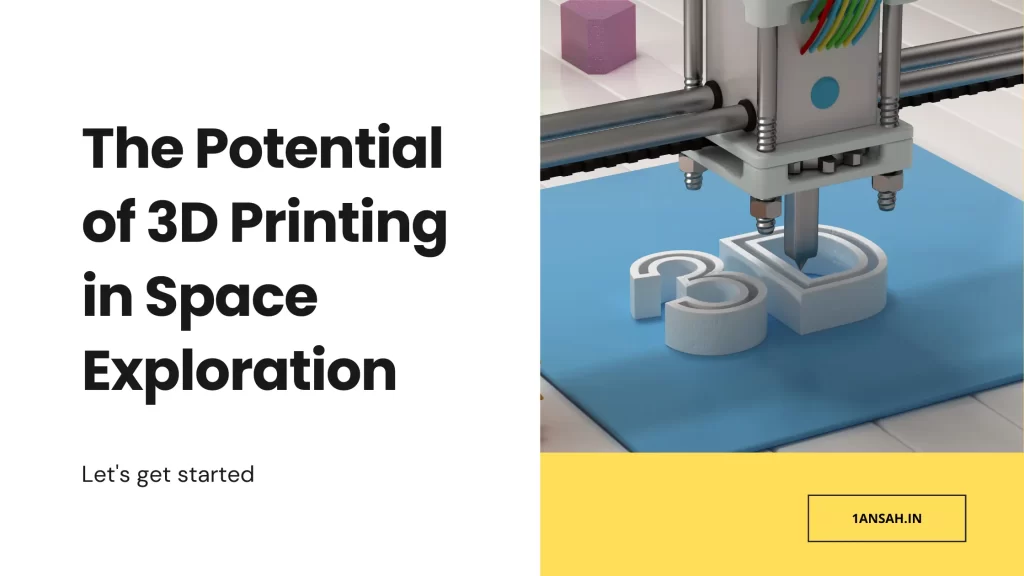Space exploration has always captivated the imagination of humanity, driving us to push the boundaries of what is possible and venture into the unknown depths of the cosmos. In recent years, advances in technology have revolutionized the way we approach space exploration, with one innovation standing out as particularly transformative: 3D printing. This cutting-edge technology has the potential to reshape the future of space exploration by offering unprecedented flexibility, efficiency, and cost-effectiveness in the design and manufacture of spacecraft components, tools, and even habitats. From printing food in space to constructing lunar habitats using locally sourced materials, the potential applications of 3D printing in space exploration are vast and promising. In this essay, we will explore the myriad ways in which 3D printing is poised to revolutionize space exploration and pave the way for humanity’s continued journey into the cosmos.
3D Printing: Redefining Manufacturing Beyond Earth’s Bounds
In the vast expanse of space, traditional manufacturing methods encounter numerous challenges. However, 3D printing emerges as a transformative technology, offering unparalleled flexibility and adaptability in extra-terrestrial environments. Unlike conventional manufacturing, which relies on complex supply chains and extensive resources, 3D printing enables on-demand production of essential components using locally available materials. This capability not only reduces dependency on Earth but also revolutionizes the way we approach space exploration and colonization.
From Moon Bases to Mars Colonies: 3D Printing’s Role in Extra-terrestrial Habitats
The vision of establishing human settlements on the Moon and Mars necessitates innovative approaches to construction and infrastructure development. 3D printing emerges as a cornerstone technology in this endeavor, offering the ability to fabricate habitats and structures using lunar or Martian regolith. By harnessing indigenous materials and leveraging additive manufacturing techniques, we can envision self-sustaining habitats that provide protection from radiation and extreme temperatures, paving the way for sustainable colonization beyond Earth.
Printing Tools on Demand: How 3D Printing Aids Astronauts in Space
Space missions often encounter unforeseen challenges that require immediate solutions. In such scenarios, traditional manufacturing methods fall short due to logistical constraints and time sensitivity. However, with 3D printing capabilities onboard spacecraft and space stations, astronauts can fabricate tools and replacement parts on demand, significantly enhancing mission flexibility and resilience. Whether repairing critical equipment or improvising solutions for unexpected obstacles, 3D printing empowers astronauts to overcome challenges with agility and resourcefulness.
Exploring the Cosmos with 3D-Printed Satellite Components
Satellites play a crucial role in space exploration, providing invaluable data for scientific research, communication, and Earth observation. To maximize their efficiency and functionality, satellite components must be lightweight, durable, and precisely engineered. 3D printing offers a cost-effective solution for producing intricate satellite parts with unmatched precision and complexity. By leveraging additive manufacturing techniques, researchers can design and fabricate custom components that optimize satellite performance while reducing production costs and lead times.
The Martian Toolbox: Crafting Solutions with 3D-Printed Parts
In the harsh and unforgiving environment of Mars, astronauts must rely on ingenuity and innovation to overcome challenges and ensure mission success. 3D printing emerges as a versatile tool in the Martian toolbox, enabling astronauts to fabricate essential parts and equipment on-site using locally available resources. Whether repairing habitat modules, constructing makeshift shelters, or improvising tools for scientific experiments, additive manufacturing technologies empower astronauts to adapt to unforeseen circumstances and thrive in the extreme conditions of the Red Planet.
Sustainable Space Exploration: 3D Printing for Recycling
Sustainability is a paramount consideration in space exploration, where resources are scarce and environmental impact must be minimized. 3D printing offers a sustainable solution by enabling efficient resource utilization and waste reduction. In addition to fabricating new components, additive manufacturing techniques can be used to recycle and repurpose existing materials, thereby extending the lifespan of equipment and minimizing the need for resupply missions. By embracing 3D printing for recycling and resource management, space agencies can pave the way for long-term sustainability in space exploration endeavors.
3D-Printed Implants and Prosthetics:
In the harsh and unpredictable environment of space, astronauts are susceptible to a myriad of health challenges, ranging from bone density loss to traumatic injuries. Traditional medical interventions often face logistical constraints and limited resources, making timely treatment a significant concern. However, with advancements in 3D printing technology, medical solutions can be customized and fabricated on demand, directly addressing the unique needs of individual astronauts. Whether producing implants for bone regeneration or crafting prosthetics for injured crew members, additive manufacturing revolutionizes space medicine, ensuring the health and well-being of astronauts on long-duration missions.
Miniature Satellites, Maximized Potential:
CubeSats, small and cost-effective satellites, have revolutionized space exploration by enabling affordable access to space for a wide range of applications. 3D printing plays a crucial role in CubeSat development, offering rapid prototyping and customization capabilities that traditional manufacturing methods cannot match. By leveraging additive manufacturing techniques, researchers can design and fabricate CubeSat components with unprecedented speed and precision, accelerating the pace of innovation and expanding the capabilities of these miniature satellites. From Earth observation to telecommunications, 3D printing unlocks new possibilities for CubeSat missions, paving the way for a more accessible and democratized space ecosystem.
3D-Printed Rocket Engines:
The propulsion systems of spacecraft are critical components that determine mission success and efficiency. Traditional manufacturing methods for rocket engines are complex, expensive, and time-consuming, posing significant challenges for space exploration. However, with advancements in 3D printing technology, we can revolutionize rocket engine production by leveraging additive manufacturing techniques to fabricate complex geometries with enhanced performance and reliability. By embracing 3D-printed rocket engines, space agencies can reduce costs, accelerate development timelines, and unlock new possibilities for space exploration and transportation.
Zero-Gravity Manufacturing: Challenges and Innovations
The unique microgravity environment of space presents both challenges and opportunities for additive manufacturing. Traditional 3D printing processes rely on gravity to maintain layer adhesion and structural integrity, posing challenges in zero-gravity conditions. However, researchers have developed innovative solutions to overcome these obstacles, including modified printing techniques, specialized materials, and advanced printing technologies. By addressing the complexities of zero-gravity manufacturing, we can harness the full potential of 3D printing in space, paving the way for on-demand production of critical components and infrastructure in orbit and beyond.
On-Demand Spacecraft Repairs:
Space missions are inherently risky endeavors, and unforeseen mechanical failures can jeopardize mission objectives and astronaut safety. Traditional approaches to spacecraft maintenance and repair rely on extensive pre-planning and spare parts inventory, which may not always be feasible or practical in the dynamic environment of space. However, with onboard 3D printing capabilities, astronauts can fabricate replacement parts and perform repairs on-site, minimizing downtime and ensuring mission continuity. Whether repairing critical systems or improvising solutions for unexpected emergencies, additive manufacturing empowers astronauts to overcome challenges with agility and ingenuity, demonstrating the transformative potential of 3D printing in space exploration.
Beyond Plastic: Experimenting with Extra-terrestrial Materials for 3D Printing
In the realm of space exploration, the utilization of 3D printing technology has opened up new possibilities, especially in the quest to find alternatives to traditional plastic-based materials. One exciting avenue being explored is the use of extra-terrestrial materials for 3D printing. Scientists and engineers are investigating the feasibility of utilizing resources found on other celestial bodies, such as the Moon or Mars, to create construction materials for space habitats and infrastructure. By leveraging in-situ resources, space missions can become more sustainable and self-sufficient, reducing the need to transport materials from Earth.
Customized Space Suits:
One of the key benefits of using 3D printing for space suits is the ability to create bespoke designs that perfectly fit each astronaut’s unique body shape and size. By using precise measurements and advanced scanning techniques, engineers can fabricate space suits that offer optimal comfort and mobility, reducing the risk of fatigue and injury during long-duration missions.
Furthermore, 3D printing enables the integration of specialized features directly into the suit’s structure, such as built-in sensors for monitoring vital signs or flexible joints for enhanced mobility. These customizations not only improve the functionality of the space suit but also enhance the overall safety and performance of astronauts in space.
Mapping Alien Worlds: 3D Printing’s Role in Planetary Exploration Tools
Exploring alien worlds requires advanced tools and instruments capable of capturing detailed data about their terrain, atmosphere, and geology. 3D printing technology is playing an increasingly vital role in the development of these planetary exploration tools, providing scientists and engineers with innovative solutions for mapping and studying distant worlds. One of the primary advantages of using 3D printing for planetary exploration tools is the ability to create complex and intricate designs that are difficult or impossible to manufacture using traditional methods.
How 3D Printing Lowers Costs and Increases Efficiency:
The integration of 3D printing technology in space missions has brought about a significant revolution in the aerospace industry. One of the most notable advantages is the cost reduction associated with manufacturing spacecraft components. Traditional manufacturing methods often involve extensive machining and assembly processes, which can be time-consuming and expensive. However, with 3D printing, complex parts can be produced quickly and with minimal waste, leading to substantial cost savings. Additionally, the efficiency of 3D printing enables rapid prototyping and design iteration, allowing engineers to optimize spacecraft components for performance and reliability.
The Journey of 3D-Printed Spacecraft Components:
The journey of 3D-printed spacecraft components begins with the conceptualization and design phase, where engineers leverage computer-aided design (CAD) software to create intricate models of the desired parts. Once the designs are finalized, they are converted into digital files compatible with 3D printers. During the manufacturing process, additive manufacturing techniques are used to build up layers of material, such as metals or polymers, to create the final components. After undergoing rigorous testing and quality control checks, the 3D-printed parts are integrated into the spacecraft assembly and prepared for launch. This seamless integration of 3D printing technology into the spacecraft manufacturing process streamlines production timelines and ensures that missions are equipped with high-quality, precision-engineered components.
The potential of 3D printing in space exploration is boundless, offering a glimpse into a future where humanity ventures further into the cosmos with unprecedented efficiency and innovation. From revolutionizing the way we manufacture spacecraft components to enabling sustainable colonization of other celestial bodies, 3D printing has already begun to reshape the landscape of space exploration. As technology continues to advance and our understanding of the universe deepens, the possibilities for 3D printing in space exploration will only continue to expand. By harnessing the power of this transformative technology, we are not only unlocking new frontiers in space but also laying the groundwork for a future where humanity’s reach extends beyond Earth’s bounds.

